E-Mail a Question
Please include reference ID Ref-ID with your question.
Send an e-mail question to the Q & A Forum: rushlight_qa@rushlight.org
The link above will add the reference ID to the subject line of your default e-mail program.
The e-mail address for all questions and comments is: rushlight_qa@rushlight.org
Ask a Question by Mail
Please provide complete information when sending mail:
- Provide as Detailed a Description of the Item as Possible
- Include Photographs of the Item
- Include the five-character reference ID shown above.
- Mail questions, comments and replies to:
- BRETT EWALD, Q&A FORUM
- 412 ROBIN RD
- VILLAS NJ 08251-1141
E-Mail a Comment or Reply
If referencing a specific question; please include the question ID.
Click here: rushlight_qa@rushlight.org to send an e-mail to the Q & A Forum.
Send a Reply or Comment by Mail
Click here for Mailing Address
Usage Guidelines & Terms of Use
Questions should be sbmitted by e-mail if possible.
For best results, please provide the following information:
- Provide a Detailed Description of the Item:
This should include any manufacturer's and patent marking. Patent marks are typically found on wick knobs, flame spreaders, burner parts, fill caps and fount tops. Patent marks also may sometimes be found on internal burner parts. Glass lamps may have marks molded into the glass, often on the foot or base.
- Send Photographs of the Item: Requests for identification should be accompanied by photographs. For Example: An overall photo and if applicable, detail photos of the fount, burner, flame spreader, wick knobs or wick raising mechanism. A photo of any unique features will greatly help in identification. Photos are easily sent via attachment to your e-mail. The preferred image file format is jpg.
Terms of Use
The Rushlight Club offers this Q&A Forum to assist individuals in the identification of lighting devices and lighting related items as a means to assist in the study of early lighting. The Q&A Forum may not be used for any commercial purpose. Questions relating to the value or rarity of items are outside the purpose of this forum and will not be answered. No items may be listed for sale.
Questions, photos, answers, comments or other items deemed to be of general interest may be posted on this website or included in Club publications. By submitting information the user grants the Rushlight Club a license to publish the information supplied. The posting or publishing of such material will be at the discretion of the Rushlight Club Inc.
NO PERSONAL INFORMATION such as your address, phone number or e-mail address will be listed on the Rushlight website or in any Club publication.
Copyright © 2021 The Rushlight Club Inc.
View Answered Questions
Question Ref. 3CHF8: I have a pair of early 18 th century (or so I've been told) pewter whale oil lamps, made in France or Spain. These are in excellent shape and feature a small Angel marking on each handle. Please see the enclosed photos. If you may have some information about these --- please email me. Thank you very much for your time. Darren
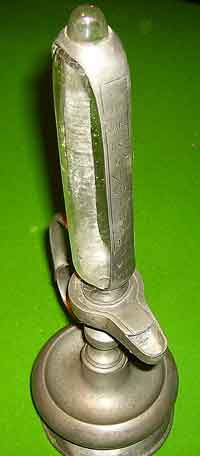
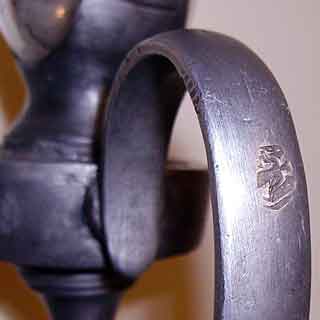
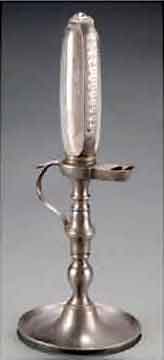
Answer: This is a European, probably German time indicating lamp. The Roman numerals correspond to the passage of time as the fuel is consumed. It works on the Cardan or "bird fountain" principle, which maintains a constant flow of fuel to the wick until it is consumed. These lamps burned a variety of fuels, including vegetable, and possibly, whale oils.
Another example is shown at right. For other examples see Figures 10-9 and 10-10 on page 86 of Early Lighting.
Without personal examination of the lamp, it's not possible to determine if it is original, or to provide a date of manufacture, as there are numerous reproductions. Many German pewter lamps, as well as Italian (brass lucernas, clay lamps) were produced as souvenirs for the foreign traveler. The time period for originals would be late 18th to mid 19th Centuries. Reproductions date from late 19th through the first half of the 20th Centuries. Your lamp, if original, possibly dates to the 18th Century, but is more likely early 19th Century.
Question Ref. 39E2X: I have a "The A.B.E. CO. CLEVELAND OHIO STREET LIGHT", brass with the entwined AB monogram and original label. I saw a similar street light in front of the White House in a old painting, circa early 1900's, Any info on this light would be welcome. I attached a few photos.
Feel free to contact me with any questions. George
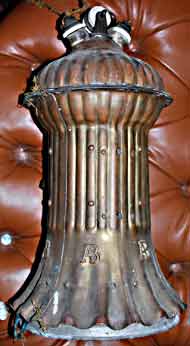
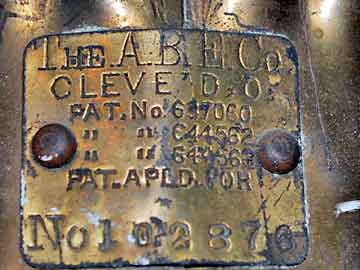
Answer: Your photo shows the outer housing of an enclosed arc lamp manufactured by the Adams-Bagnall Electric Co, of Cleveland, Ohio.
Adams-Bagnall Electric Co. Information
Arc lighting, in which light is produced by the sparking, or "arcing," of electricity in open air between two carbon electrodes, was extensively used for outdoor illumination and illumination of large interior spaces (e.g., train sheds, factories, department stores) until the advent of the gas-filled tungsten filament incandescent lamp (light bulb) c. 1913, and was complementary to the carbon filament incandescent lamp, used principally in homes and offices, invented by Thomas A. Edison.
Your example is missing the entire operating mechanism as well as the globe or reflector. The condition of your lamp is unfortunately that of most extant arc lamps. The large gas-filled tungsten incandescent lamps, introduced in the years just before World War I, which gave the equivalent amount of light to an electric arc and eliminated the need for trimming, resulted in most arc lamps being eventually converted to incandescent lamps by removal of the arc light mechanism. Photos of a complete Adams-Bagnall arc lamp like yours with the mechanism and a video of it functioning is on the web at: www.electricmuseum.com/adams-bagnall-arc-lamps
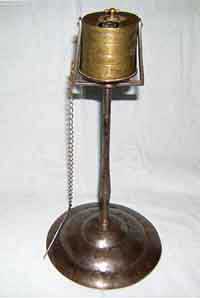
Question Ref. 39D3V: I recently purchased the Peter Derr gallows/kettle lamp shown in the attached photo. I don't know much about these lamps and can't find any information on them. Which name, gallows or kettle, is correct? Why do they have a long shaft with a swivel font? Why did some have lids on the font? They don't appear practical, are they? Sometimes they are referred to as barn lamps. Is that correct? I have also heard they were predominately made and used in Eastern Pennsylvania and that some were also made and used in Europe. Is that correct? Thank you for your help.
Answer: The example shown in your photo is the typical style made by the famous Pennsylvania metal worker, Peter Derr. He coined the term "gallows" to describe his own models, although the term kettle (referring to the shape of the font), is the common term used by most authors, dealers and collectors to describe this form of lamp. The term "gallows" refers to the construction of the U shaped carriage that holds the font, and which sits on the long pole like shaft. The long shaft with a swivel (trunnion) font, and a fixed vertical wick holder, are basic design features of all kettle lamps. The swivel or trunnion construction was very practical, as it allowed the user to tip the font to provide more fuel (fat or grease) to the end of the wick. Some had lids to protect the fuel and prevent spillage. The length of the shaft appears to be more stylistic, than functional. Many examples are much shorter than the Derr design. They were first made and used in Central Europe in the 18th Century, and were brought to America by immigrants. The form was made by Derr and others, and commonly used in Pennsylvania throughout the 19th Century. They were made using a variety of metals, including iron, brass and copper, often decorated with incising on the fonts and/or knops on the shaft, and were also the subject of gifts or dowry. Given their use as household table lamps, and the sophistication of their construction, the use of the term "barn lamp" seems suspect as it is clearly a misnomer, and inappropriate.
For additional examples and information, see "The Kettle Lamp" in the March 2009 issue of The Rushlight.
Question Ref. 2XME7: Please find attached pictures of a lamp I recently bought. I would like to learn more about it. The font is tin and measures 4 7/8" in diameter and 15/16" deep. The lever moves up and down and when pushed down it raises the wick in the brass wick tube. The wick is held by a smaller wick tube that fits inside the visible tube. The inner tube is attached to the lever that goes up and down. The brass cap is where the lamp is filled. Stamped on the top are the initials S.S.W.D.M.Co.
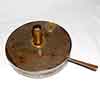
Do you know anything about this lamp ie the maker, what it was made for, what fuel it used, when was it made? Can anyone tell me if there is a patent associated with this lamp. If so what is the patent number and who was it awarded to? Who was the maker and what do the initials stand for? Thanks in advance for any information, Don
Answer: What you have is not a lamp but a laboratory alcohol burner made by a dental equipment manufacturing company. The company (S.S.W.D.M.Co.) is Samuel Stockton White Dental Manufacturing Company of Philadelphia with branches all over, including Canada. There are many such alcohol burners around in all shapes and sizes. They were used in labs, for caterers chaffing dishes and as heat sources for Victorian era live steam toys. For the complete company history visit the link below:
https://invention.si.edu/s-s-white-dental-manufacturing-company-records-1791-1970-bulk-1870-1965Question Ref. 32B5T: I am hoping that someone with your organization will be able to assist me with information regarding Excelsior Flint Glass Company out of Pittsburgh which operated during the middle to end of the 19th century.
Sincerely, Scott
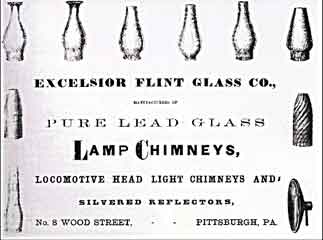
Answer: John Lowery, was one of nine partners who founded this factory in 1863 (not to be confused with The Excelsior Glass Works). Others included Edward Dithridge, John Flynn and James Lindsay. The company produced a variety of lamp chimneys, lantern globes and locomotive head light chimneys as well as silvered lamp reflectors as shown in The Glass and Crockery Journal advertisement of August 12, 1875. Using innovative techniques and processes, such as the Dithridge oval lamp chimney and Atterbury glass mold pressing, the company was a significant producer of glass in the 1870s. It participated in the 1876 International Exhibition in Philadelphia and won praise for some of its products. At that time the company had 104 employees, and produced $100,000 in sales of glass lamp chimneys, glass jars and silvered reflectors. In the 1880s, it remained a significant producer of products for railroad use, including lantern globes and locomotive headlight chimneys. In the 1890s it was still producing glass and jars, and was listed in the 1899 edition of Seeger and Guernsey's Cyclopaedia of Manufacturers and Products in the US even though the company actually ceased operations sometime prior to 1899.
For more information on the company see Glasshouses and Glass Manufacturers of the Pittsburgh Region 1795-1910, by Jay W. Hawkins (2009) and Pittsburgh Glass 1791-1891, by Lowell Innes (1976).
The Rushlight Club Inc. www.rushlight.org